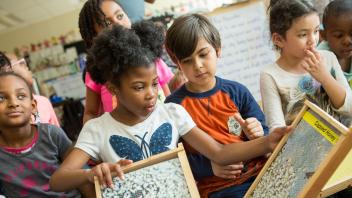Teacher question:
I am an elementary school principal. I’ve heard a lot recently about disciplinary literacy. Our school isn’t doing enough with that in my opinion. What do you think? What should I have my teachers doing with disciplinary literacy?
Shanahan’s response:
Over the past three decades research has shown that people read differently in the different disciplines. Historians, for instance, read different kinds of texts, for different purposes, and they weigh evidence differently, and focus on different kind of information in the texts that they read than do literary critics or scientists.
Reading starts out pretty generalizable. The skills we use to decode text are the same no matter what you read. The same can be said about the basics of comprehension. Informational texts in grade 2 are like each other in most respects, no matter what field of study the information is drawn from.
But as text gets more sophisticated things start to diverge. Content is not the only distinguishing feature of science, mathematics, history, and literature texts.
These differences appear to be linked to how knowledge is created in the different disciplines and the nature of the knowledge created. Historians devote what, in other disciplines, may seem to be inordinate amounts of time focused on the varied perspectives of participants in and observers of historical events. Scientists, on the other hand, don’t pay much attention to those kinds of differences, but focus on methodological rigor and replication.
As a result of all this, most states have disciplinary literacy standards for grades 6-12. We want our kids to read at high levels and that means being able to read like historians, mathematicians, scientists, and literary critics.
Terrific.
But what about elementary school?
Should elementary school teachers teach disciplinary literacy?
Possibly a little, but, in the main, my answer is no. It doesn’t make sense to teach disciplinary literacy until kids are confronting the demands of truly disciplinary texts. This might start to happen in the upper elementary grades, which is why I say, “a little.” But most of the reading time in social studies, science, and math class should be more basic than that.
The main contribution that elementary teachers can make is to get kids ready to take on the rigors of disciplinary literacy by the time they reach middle school and high school. Here are some of the things you can do to smooth the path to disciplinary literacy success:
1. Build basic literacy skills
When I speak to high school teachers, their number 1 complaint/concern are the kids who can’t read well enough to participate fully in disciplinary learning. Too many kids are allowed to slip through the cracks. They are just too far behind by the time they are expected to take on disciplinary reading demands.
To accomplish sufficient elementary reading levels, kids should get a strong dose of decoding instruction in the primary grades. In studies of successful phonics instruction, kids were usually provided about 30 minutes per day of such teaching. Likewise, readers benefit from substantial oral reading or text reading fluency.
Unfortunately, too many children spend grades 2-5 focused on books that are too easy to ensure a sound flight path to disciplinary literacy. The idea of placing kids in below grade level books because they can already read those seriously disadvantages them. We need to teach students to comprehend texts that they may not already be able to read well, that will give them the best chance of being ready for middle school and high school reading.
2. Develop content knowledge
I often hear elementary teachers say that the only thing that matters is that their students learn to read. That’s too limited a view of reading. Reading depends on knowledge and too often the time devoted to social studies, science, and the arts are squandered. Study after study shows how little our kids know about geography, history, science, and the like.
Teachers need to be pro-knowledge. The more kids know about their social and scientific worlds the brighter their future possibilities. We need to make sure that elementary content classes are worth something. Protect the time devoted to them, monitor kids’ learning of that content, and provide frequent and ongoing review.
3. Expose kids to informational text
With young children, the emphasis of shared reading and reading instruction is usually on stories alone. That’s a big mistake. When you’re choosing books to read to kids, consider a broader range of choices — choices that would expose kids to a broader range of texts. (I vividly remember reading Jane Goodall’s In the Shadow of Man to my young daughter.) Think about this, too, when stocking classroom libraries or selecting reading programs. And, when it comes to the texts in social studies or science classes do more than round robin reading; actually, teach the students how to read those books and don’t just tell them everything the books say. Give them a real chance to acquire knowledge from their reading (and rereading), rather than treating the reading as a time-filling activity.
No, elementary teachers aren’t responsible for teaching students the unique or specialized of reading in the different disciplines. But they are accountable for preparing students, so they’ll be ready to learn those things in middle school and high school. For too many students, those things aren’t happening. We can do something about that.

